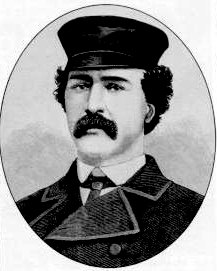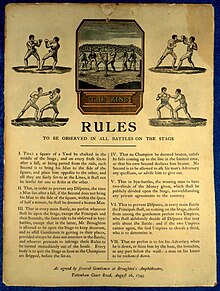
Boxing is a combat sport and martial art. Taking place in a boxing ring, it involves two people – usually wearing protective equipment, such as protective gloves, hand wraps, and mouthguards – throwing punches at each other for a predetermined amount of time.

Kickboxing is a full-contact hybrid martial art and boxing type based on punching and kicking. Kickboxing originated in the 1950s to 1970s. The fight takes place in a boxing ring, normally with boxing gloves, mouth guards, shorts, and bare feet to favor the use of kicks. Kickboxing is practiced for self-defense, general fitness, or for competition. Some styles of kickboxing include: full contact karate, Muay Thai, Japanese kickboxing, Lethwei, Sanda, and Savate.

A boxing ring, often referred to simply as a ring or the squared circle, is the space in which a boxing match occurs. A modern ring consists of a square raised platform with a post at each corner. Four ropes are attached to the posts and pulled parallel under tension with turnbuckles to form the boundary of the competition area.

The Marquess of Queensberry Rules, also known as Queensbury Rules, are a set of generally accepted rules governing the sport of boxing. Drafted in London in 1865 and published in 1867, they were so named because the 9th Marquess of Queensberry publicly endorsed the code, although they were actually written by a Welsh sportsman, John Graham Chambers, from Llanelli, Carmarthenshire. They were the first to mandate the use of gloves in boxing.

Bare-knuckle boxing is a full-contact combat sport based on punching without any form of padding on the hands. The sport as it is known today originated in 17th-century England and differs from street fighting as it follows an accepted set of rules.

Patrick Ryan was an Irish American boxer, and became the bare-knuckle American heavyweight champion on 30 May 1880, after he won the title from Joe Goss. He retained the title until losing it to the exceptional John L. Sullivan on 7 February 1882.

The London Prize Ring Rules were a list of boxing rules promulgated in 1838 and revised in 1853. These rules were based on those drafted by England's Jack Broughton in 1743 and governed the conduct of prizefighting/ bare-knuckle boxing for over 100 years. They "introduced measures that remain in effect for professional boxing to this day, such as outlawing butting, gouging, scratching, kicking, hitting a man while down, holding the ropes, and using resin, stones or hard objects in the hands, and biting." They were later superseded by the Marquess of Queensberry Rules, which were the origin of the modern sport of boxing.

John "Jack" Broughton was an English bare-knuckle boxer. He was the first person to codify a set of boxing rules; prior to this the "rules" that existed were very loosely defined and tended to vary from contest to contest. His seven rules were widely used in boxing for nearly a century, until they were replaced by the London Prize Ring rules in 1838. Pierce Egan characterised Broughton as the "Father of the English School of Boxing".

Boxing gloves are cushioned gloves that fighters wear on their hands during boxing matches and practices. Unlike "fist-load weapons" which were designed as a lethal weapon, modern boxing gloves are non-lethal, designed to protect both the opponent's head and the fighter's hand during a bout. Sparring and other forms of boxing training have their own specialized gloves.

Simon Byrne, nicknamed "The Emerald Gem", was an Irish bare-knuckle prize fighter. The heavyweight boxing champion of Ireland, he was drawn to England by the larger sums of prize money on offer and his hopes of becoming the heavyweight champion there as well. He became one of only six fighters ever to have been involved in fatal fights as both survivor and deceased since records began in 1741.

Tom Spring was an English bare-knuckle fighter. He was champion of England from 1822 until his retirement in 1824. After his retirement he became landlord of the Castle Inn at Holborn in London, where he arranged the patronage and contracts of many of the major boxing events of the period while overseeing fair play in the ring.

Professional boxing, or prizefighting, is regulated, sanctioned boxing. Professional boxing bouts are fought for a purse that is divided between the boxers as determined by contract. Most professional fights are supervised by a regulatory authority to guarantee the fighters' safety. Most high-profile bouts obtain the endorsement of a sanctioning body, which awards championship belts, establishes rules, and assigns its own judges and referees.

Young Barney Aaron was a bare-knuckle boxer.

Frank Capcino, better known by his ring name Frank Cappuccino, was a boxing referee best known for having officiated over some of the most famous boxing matches in history.
Tom Johnson was a bare-knuckle fighter who was referred to as the Champion of England between 1784 and 1791. His involvement in pugilistic prizefighting is generally seen to have coincided with a renewed interest in the sport. Although a strong man, his success was largely attributed to his technical abilities and his calm, analytical approach to despatching his opponents. But Johnson was less prudent outside the ring; he was a gambler and considered by many of his acquaintances to be an easy mark. He is thought to have earned more money from the sport than any other fighter until nearly a century later, but much of it was squandered.

Dick Curtis was an English bare-knuckle boxer who was considered the best and most powerful English lightweight of his era. He had only one loss in his career and was inducted into the International Boxing Hall of Fame in 2006.

Mike McCoole, sometimes spelled McCool, was an Irish-born bare-knuckle boxing champion who came to America at the age of thirteen. He claimed the Heavyweight Championship of America in 1866 by defeating boxer Bill Davis after former champion Joe Coburn retired, and lost the title to Tom Allen in 1873.

Tom Allen was a British bare-knuckle boxer who claimed the Heavyweight Championship from 1873, when he defeated Mike McCoole, until 1876, when he lost to Joe Goss. For much of his earlier career he fought just above the middleweight range, around 165-75, making him smaller than most of the heavyweights he met, he became an American citizen later in life.

Owen Swift was a British bare-knuckle prize fighter, who killed three men in boxing bouts. The death of "Brighton Bill" in one particularly savage 85-round bout in 1838, and Swift's subsequent conviction for manslaughter, led to the adoption of the London Prize Ring Rules.
Events in world sport through the years 1741 to 1745.
















